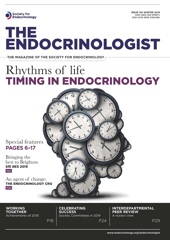Rhythms characterise all living things, from the type of content we post on Twitter,1 to the metabolism of individual cells in every part of our bodies.2
Rhythms that oscillate over days, weeks or longer, such as the human menstrual cycle, are termed ‘infradian’. ‘Circadian’ rhythms have an intrinsic period close to 24 hours. The sleep hormone melatonin is circadian. Its rhythm persists despite the absence of external environmental cues and is therefore a useful marker of circadian phase.
‘Diurnal’ rhythms describe patterns of activity that mainly occur in the daytime: thus a diurnal rhythm may or may not also be circadian. Daily physical activity is an example of a diurnal rhythm in most people. Rhythms that occur with a period of less than 24 hours are ‘ultradian’, and may be as short as a few minutes – as in the case of insulin secretion.
Cortisol, the glucocorticoid hormone that is vital for both survival and the acute stress response, shows a diurnal circadian rhythm and superimposed ultradian rhythm in humans.3 Pulsatile secretion of cortisol occurs approximately every 90 minutes and can be observed in healthy people when blood sampling is frequent enough.4 In fact, cortisol pulsatility persists even in pathological states, such as Cushing’s, caused by adrenocorticotrophin-secreting pituitary tumours.5
WHAT CAUSES THE GLUCOCORTICOID ULTRADIAN RHYTHM?
Previously, it was considered that a pulse generator must exist in the hypothalamus to account for these rapid oscillations. However, while lesions to the master clock in the suprachiasmatic nucleus abolish circadian rhythms in rodents, they do not disrupt cortisol pulsatility,6 which remains ultradian.
An alternative hypothesis is that cortisol pulsatility is itself an intrinsic property of the hypothalamic-pituitary axis. Mathematical modelling predicts that ultradian secretion of cortisol is due to the dynamic interaction between positive ‘feed-forward’ from the hypothalamus and pituitary, and negative feedback from cortisol produced by the adrenal gland.7 This theory has been supported by rodent experiments where ultradian oscillations of cortisol continue in spite of constant corticotrophin-releasing hormone infusion.8 Rapid negative feedback by glucocorticoid inhibition must be the key factor that regulates the dynamic ultradian rhythm.
ARE ULTRADIAN RHYTHMS IMPORTANT?
As we have seen, the rhythm of glucocorticoids is highly dynamic. Early in the morning, there is a circadian rise in cortisol that anticipates waking and prepares the individual for the challenges of the day. However, the hormone doesn’t then simply decline smoothly over the day; secretion continues in burst-like pulses that decrease in amplitude until the nadir is reached overnight.
Recognising that the glucocorticoid rhythm is complex should help clinicians and others to understand why single time-point measurements of cortisol are difficult or impossible to interpret, why the healthy normal range for morning cortisol is so broad, and why normal variation can frequently overlap with pathological states such as Cushing’s syndrome.
Evidence that the ultradian rhythm of cortisol is metabolically important comes from animal and tissue experiments, and more recently in humans. Pulsatile compared with continuous exposure to glucocorticoids alters the expression of genes in many tissues, including the liver and brain.9 Furthermore, in adrenalectomised rats, the response to stress was blunted when cortisol was replaced continuously rather than in a pulsatile manner.10
Recent work by PhD student Ben Flynn (University of Bristol) has shown that binding of the glucocorticoid receptor to DNA is dynamically synchronised with pulsatile signals of cortisol. In contrast, when there is continuous exposure to cortisol, transcription of glucocorticoid receptor-dependent genetic targets involved in metabolic regulation is significantly altered.
‘New treatment approaches that consider the importance of ultradian, as well as circadian, variation are now emerging as potential new tools for endocrinologists in clinical practice.’
STUDIES IN HUMANS
Evidence of the physiological relevance of glucocorticoid pulsatility in humans has thus far not been well described and is a clear area for future research.
One hypothesis is that the poorer quality of life and health outcomes commonly reported in patients with Addison’s disease11 could at least partly be attributed to the lack of endogenous glucocorticoid pulsatility as well as non-physiological replacement dosing. In a study of healthy volunteers, cortisol was suppressed using metyrapone. Participants then received hydrocortisone, either by means of standard oral doses, via smooth ‘circadian’ subcutaneous infusion, or as a series of ultradian subcutaneous pulses. The same total dose of hydrocortisone was given in all three settings. The ultradian replacement was associated with better self-reported sleep quality, better working memory and differential connectivity in brain regions important for emotional processing.12
The PULSES trial (www.isrctn.com/ISRCTN67193733) aimed to explore this through the novel use of subcutaneous pulsatile glucocorticoid replacement, compared with standard oral doses, in patients with Addison’s and congenital adrenal hyperplasia. Preliminary results presented at the recent Society for Endocrinology BES conference in Brighton indicate that as in healthy volunteers, the pattern of glucocorticoid replacement is extremely important for normal cognitive function.
Better understanding of the dynamics of adrenal hormones should also contribute to improvements in endocrine diagnosis and treatment. The ULTRADIAN Dynamic Hormone Diagnostics multicentre trial (www.ultradian.eu) is currently recruiting both healthy volunteers and patients with endocrine diseases. In this study, healthy adrenal steroid dynamics measured using novel, non-invasive ambulatory sampling technology are compared with the dynamics of endocrine diseases such as Cushing’s, Addison’s and primary aldosteronism. By measuring hormones repeatedly over 24 hours, far more information can be gathered about both healthy normal variation and pathological hormone states. This information will then be integrated using mathematical algorithms and machine-learning techniques to reduce diagnostic time and make management decisions more personal to each patient.
IN SUMMARY
Our lives are rhythmic on scales that range from months to minutes. Each rhythm is important and, together, they create an environment of dynamic equilibrium.
When it comes to the clinic, understanding that single, integrated or limited time-point measurements may be inaccurate or misleading is essential. Likewise, being mindful that many of our treatments do not mimic physiological rhythmicity may be extremely important for patient well-being. New treatment approaches that consider the importance of ultradian, as well as circadian, variation are now emerging as potential new tools for endocrinologists in clinical practice.
Thomas Upton, Clinical Research Fellow, University of Bristol
REFERENCES
- Dzogang F et al. 2018 PLoS One 13 doi: 10.1371/journal.pone.0197002.
- Eckel-Mahan K & Sassone-Corsi P 2013 Physiological Reviews 93 107–135.
- Veldhuis JD et al. 1989 American Journal of Physiology 257 E6–E14.
- Henley DE et al. 2009 Journal of Medical Engineering & Technology 33 199–208.
- Roelfsema F et al. 2014 Journal of Clinical Endocrinology & Metabolism 99 3836–3844.
- Wait EJ et al. 2012 European Journal of Neuroscience 36 3142–3150.
- Walker JJ et al. 2010 Proceedings of the Royal Society B 277 1627–1633.
- Walker JJ et al. 2012 PLoS Biology 10 e1001341.
- Stavreva DA et al. 2009 Nature Cell Biology 11 1093–1102.
- Sarabdjitsingh RA et al. 2010 Endocrinology 151 5369–5379.
- Bensing S et al. 2016 European Journal of Endocrinology 175 R107–R116.
- Kalafatakis K et al. 2018 Proceedings of the National Academy of Sciences of the USA 115 E4091–E4100.






